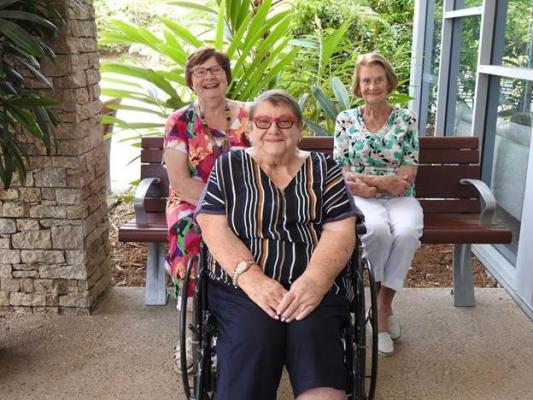It has been a year that will long remain in the memories of Noosa Care at Tewantin. Just 12 months ago bushfires threatened bushland beside the facility forcing its evacuation. In January they weathered a lightning strike then in March the threat of COVID arrived.
When the COVID-19 pandemic was at its height across Australia and aged care facilities were bearing the brunt of the virus residents at Noosa Care felt safe and protected. The community-based not-for-profit organisation operates Carramar at Tewantin and Kabara in Cooroy.
This week CEO Megan D’Elton and Carramar residents Jill Shaw, Peg Burgin and Christine Milligan spoke to Noosa Today about their COVID experience.
It was at the beginning of the year talk began about the COVID virus, Megan said.
The facility had dealt with threats of previous viruses before and managed well.
“We were mostly concerned at what it was,“ Megan said. “At first it was overseas, we didn’t know how it was going to affect us.“ Then it was in the Shire.
“Everybody in aged care was getting correspondence about what they should be doing to prepare for it, what COVID was“.
Megan said plans they had in place to control infection they adjusted to control COVID and have continued to update and adjust as more information on the pandemic was received.
“We shut our site to all visitors for four weeks,“ she said. “That gave our residents peace of mind and gave staff a sense of safety. “Communication was key to keeping everyone calm, informed and abreast of the changing environment and Noosa Care used all means available to them including telephone, email and Skype to maintain communication with residents, relations and staff.
“We tried to make like as normal as possible inside for our residents but they couldn’t go out on the bus,“ she said.
The facility employed extra staff, mostly hotel staff, to take on extra tasks of cleaning and non-essential care that took the burden of extra duties from usual staff to enable them to care for their clients.
As restrictions eased visitors were slowly able to return on restricted times and in reduced numbers and documents had to be maintained to track every visitor. They employed extra reception and booking staff to maintain records.
We had to ensure if visitors came from overseas or interstate that they had been quarantined, had received a negative COVID-test and everyone was required to have an influenza vaccination, Megan said.
Dealing with the disease threat has been expensive and while the government provided some financial assistance in the form of COVID payments it hasn’t been enough to cover the facilities extra and ongoing expenses.
Megan said they needed to purchase enough personal protective equipment to cover everyone for three months just in case of an outbreak and the cost of it has doubled since COVID arrived. Staff were provided with additional training and visited Noosa Hospital for instructions on the use of PPE.
Within their infection control plans has been the ability to isolate particular areas of the facility to restrict any potential outbreak and a staffing roster that kept staff in separate areas so as not to cause cross contaminate. If an outbreak occurred they planned for the option of accommodating staff onsite.
Megan said all their advice on procedures came from Queensland Health and they were updated regularly by the department.
In addition Noosa Care has had an infection control officer employed onsite for the past 20 years.
“We have always had good infection control practices,“ Megan said.
When the National Aged Care Emergency Response (NACER) program was introduced in July-August Noosa Care sent a team of their staff to Victoria to assist with the outbreak.
When they returned to work after quarantine they brought back expertise beyond what was expected, Megan said.
“We took on that knowledge and put it into our plan,“ she said.
Dealing with the pandemic has been relentless and continues. Residents are still restricted to two visitors and social distancing practices are in place, but bus trips have recommenced though low crowd destinations are now selected.
Our main aim was to keep staff and residents safe and to keep everyone going, Megan said.
“Staff have been amazing. They have focused on residents,“ she said.
Residents Jill Shaw, Christine Milligan and Peg Burgin say they had never felt frightened of the virus at all and had always felt very safe at Noosa Care.
“There were precautions that were taken for us,“ Chris said.
Jill said her family were pleased she was in such a lovely place.
“They would have been more worried if we were in the community,“ she said. While she hasn’t been able to see family members she has been in regular contact by phone and Skype. Skyping family and friends is regular practice for these modern, technically-savvy seniors with help on hand should technical difficulties arise.
Pegg said despite the shutdown she had not felt restricted at all. She said the residents were able to take lovely walks around the grounds and staff provided them activities. She said coffee mornings had been organised by staff as well as regular entertainment.
“It’s such a comfortable, happy place to be,“ she said. “You feel you’re part of a big family.“
Jill agreed, saying she would have felt more restricted living in her own home.
Chris said since COVID arrived a number of groups had been set up including a knitting group and art group.
“It’s very popular with people. I particularly like the art group,“ she said.
The trio are looking forward to spending time with family at Christmas but if restrictions are tightened again they would also be happy to spend Christmas at Noosa Care which they hear “is lovely“.







